Index
Introduction:
The ESP32, crafted by Espressif Systems, a Shanghai-based company, stands out as a series of microcontrollers. Its popularity stems from a host of features that cater to diverse needs, making it a favorite among developers worldwide with a several key features:
Affordable Cost: ESP32 microcontrollers start at $6, making them budget-friendly and accessible to a broad audience.

Low Power Consumption: ESP32 consumes minimal power, especially in low-power modes like deep sleep, enhancing energy efficiency.

Wi-Fi Capabilities: ESP32 can easily connect to Wi-Fi networks for internet access (station mode) or create its own Wi-Fi network (access point mode), facilitating IoT and Home Automation projects.

Bluetooth Support: The ESP32 supports both Bluetooth classic and Bluetooth Low Energy (BLE), expanding its utility in a variety of IoT applications.

Dual-Core Architecture: Most ESP32 models feature dual-core processors (core 0 and core 1), providing enhanced processing capabilities.

Versatile Input/Output Options: ESP32 supports a wide range of peripherals, including capacitive touch, analog-to-digital converters (ADCs), digital-to-analog converters (DACs), UART, SPI, I2C, PWM, and more.

Arduino Compatibility: Those familiar with Arduino programming can easily transition to programming the ESP32 using the Arduino style.

MicroPython Support: For those who prefer Python, ESP32 can be programmed with MicroPython firmware, offering flexibility in coding for microcontrollers and embedded systems.

Robust design: The ESP32 boasts a robust design, capable of operating reliably across a wide range of industrial environments. It can withstand temperatures from -40°C to +125°C, ensuring consistent performance even in harsh conditions.

ESP32 Development Boards
To begin your journey with the ESP32, you’ll require a reliable development board that offers all the necessary features. With a wide range of options available, each board serves a distinct purpose, catering to different project requirements.
ESP32 DevKit V1:
Ideal for beginners due to its popularity and comprehensive features, providing everything needed to start working with the ESP32.
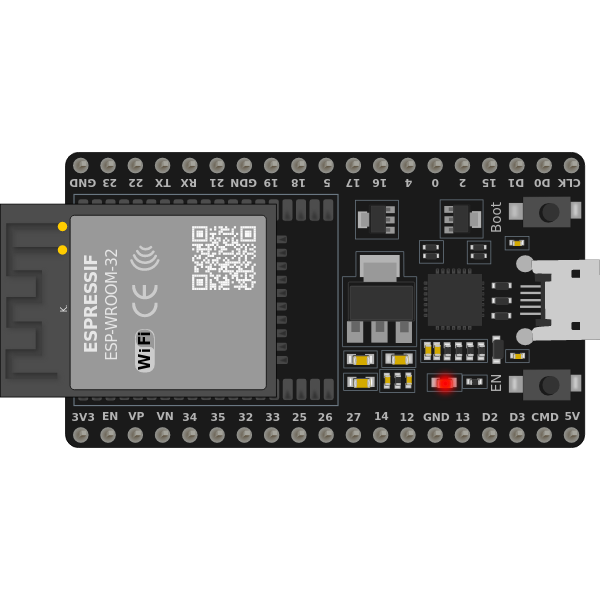
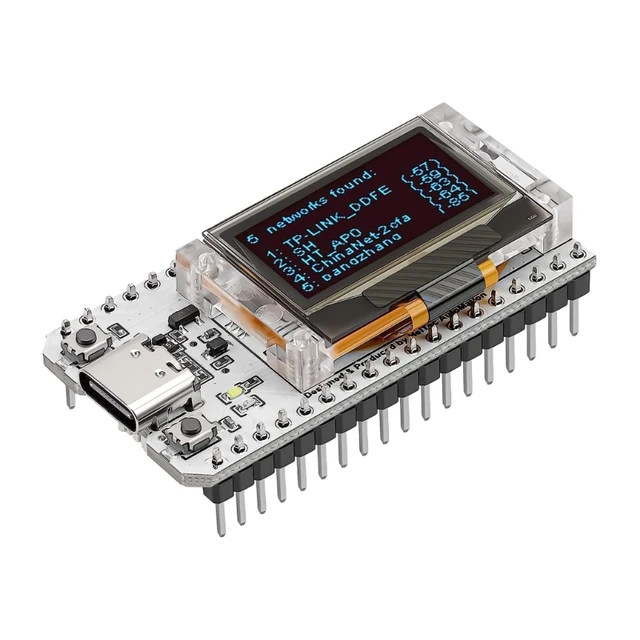
ESP32 OLED Kit:
Features an OLED display, u.FL connector for an external antenna, and a lipo battery connector, making it suitable for IoT applications requiring a display and wireless connectivity.
ESP32-CAM:
Equipped with a built-in OV2640 2MP camera and microSD card slot, making it perfect for projects involving image tracking and recognition.

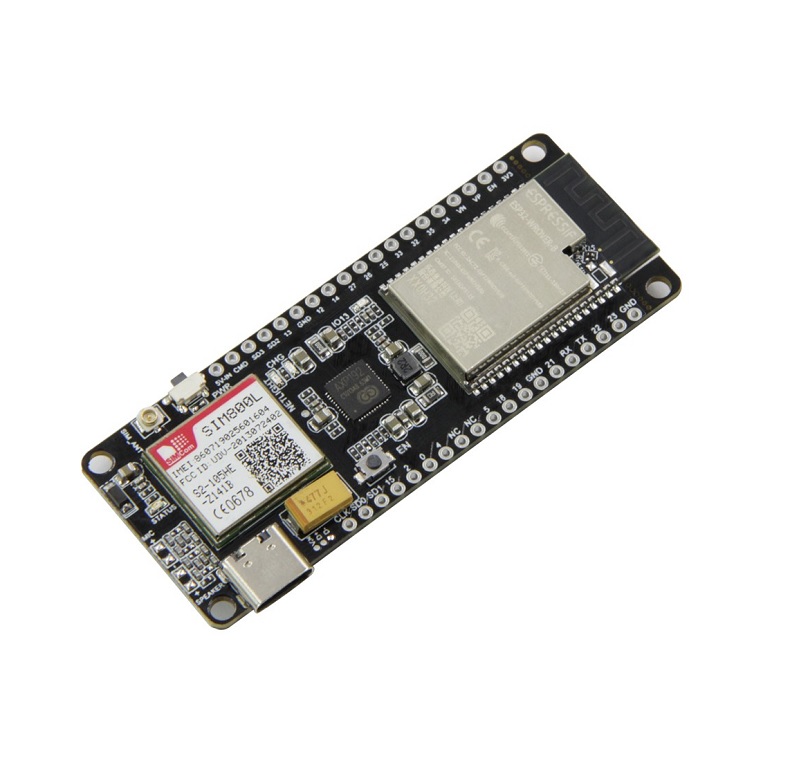
ESP32 SIM800L TTGO T-Call:
Enables Internet connectivity via a SIM card data plan, eliminating the need for Wi-Fi, which iswhere Wi-Fi is unavailable
Overview of the hardware features of ESP32 DevKit V1 board.
When considering ESP32 development boards, the ESP32 DevKit v1 stands out as the most popular choice. We’ll be utilizing this board for our experiments. If you have a different board, don’t fret; the information provided here will remain valuable.
Let’s delve into the hardware overview of the ESP32 DevKit v1 board.
ESP-WROOM-32 module
The ESP-WROOM-32 module on this development board features the Tensilica Xtensa® Dual-Core 32-bit LX6 microprocessor. Operating at a clock frequency of 80 to 240 MHz, it boasts two CPU cores that can be controlled separately. With a performance of up to 600 DMIPS (Dhrystone Million Instructions Per Second), it offers enhanced capabilities compared to the ESP8266.
- Chip: ESP-WROOM-32
- Processor: Xtensa® Dual-Core 32-bit LX6
- Clock Frequency: Up to 240MHz
- Internal SRAM: 520kB
- External Flash: 4MB
- Wi-Fi: 802.11b/g/n transceiver
- Bluetooth: 4.2/BLE

Note:
- Memory: Includes 448 KB ROM, 520 KB SRAM, and 4 MB Flash memory for program and data storage.
- Wi-Fi: Equipped with an 802.11b/g/n HT40 Wi-Fi transceiver, enabling connection to Wi-Fi networks for internet access (Station mode) or creating Wi-Fi networks (Soft access point mode).
- Wi-Fi Direct: Supports Wi-Fi Direct for peer-to-peer connections without requiring an access point, offering simpler setup and faster data transfer speeds compared to Bluetooth.
- Bluetooth: Supports both Bluetooth 4.0 (BLE/Bluetooth Smart) and Bluetooth Classic (BT), enhancing versatility.
Power:
The ESP32 operates between 2.2V and 3.6V, and its onboard LDO voltage regulator maintains stability at 3.3V. This regulator can deliver up to 600 mA, ensuring reliable performance, even during RF transmissions.
- Operating Voltage: 2.2V to 3.6V
- On-board 3.3V 600mA regulator
- Sleep Mode: Consumes 5 µA
- RF Transmissions: Requires up to 250mA

The ESP32 development board can be powered through the on-board MicroB USB connector or via the VIN pin using a regulated 5V power supply.
Peripheral functionalities and input/output:
The ESP32 offers a wide range of peripheral functionalities and input/output options:
- GPIO Pins: With a total of 48 GPIO pins, 25 of them are accessible via pin headers for various tasks.
- ADC Channels: It features 15 channels of 12-bit SAR ADC with selectable voltage ranges.
- UART Interfaces: Two UART interfaces support flow control and IrDA.
- PWM Outputs: There are 25 PWM pins available for tasks like motor speed control or LED dimming.
- DAC Channels: Two 8-bit DACs enable the generation of analog voltages.
- SPI, I2C, and I2S Interfaces: Three SPI and one I2C interfaces facilitate connectivity with sensors and peripherals, along with two I2S interfaces for sound.
- Touch Pads: Nine GPIOs come with capacitive touch sensing capabilities.
Multiplexed I/Os include:
- 15 ADC channels
- 2 UART interfaces
- 25 PWM outputs
- 2 DAC channels
- SPI, I2C & I2S interfaces
- 9 Touch Pads
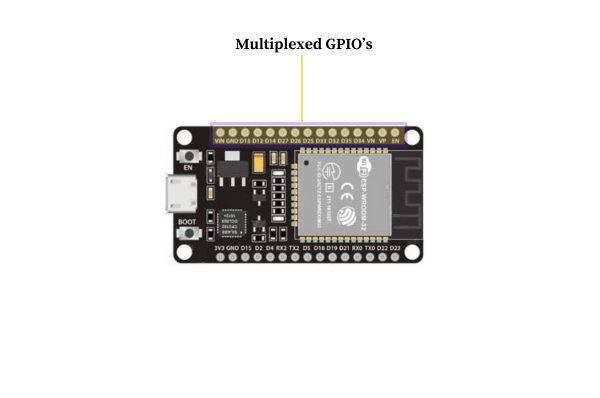
Multiplexing enables multiple peripherals to share a single GPIO pin. For instance, a GPIO pin can function as an ADC input, DAC output, or touch pad.
On Board Control and LED’s:
Reset Button (EN): Used to reset the ESP32 chip.
Boot Button: Used for downloading new software.
LED Indicators:
Red LED: Shows the board is powered on.
Blue LED: Can be programmed by the user, connected to pin D2.

Serial Communication:
The ESP32 board features the Silicon Labs CP2102 USB-to-UART Bridge Controller, enabling USB-to-serial conversion. This facilitates programming of the ESP32 chip via serial communication.
- CP2102 USB-to-UART converter
- Supports communication speeds up to 5 Mbps
- Includes IrDA support
Difference between the ESP32 and ESP8266
The ESP32 boasts enhancements over the ESP8266, featuring an additional CPU core, faster Wi-Fi, more GPIOs, and compatibility with Bluetooth 4.2 and Bluetooth Low Energy. Notably, the ESP32 incorporates touch-sensitive pins for waking up from deep sleep and includes a built-in hall effect sensor.
Despite both boards being budget-friendly, the ESP32 tends to have a slightly higher cost, ranging from $6 to $12, compared to the $4 to $6 range for the ESP8266, depending on the source and model.
In summary:
- The ESP32 demonstrates superior speed compared to the ESP8266.
- The ESP32 offers more GPIOs with versatile functionalities.
- Analog measurements are supported on 18 channels in the ESP32, surpassing the single 10-bit ADC pin on the ESP8266.
- Bluetooth capabilities are exclusive to the ESP32.
- The ESP32 operates with dual cores in most models, while the ESP8266 utilizes a single core.
- The ESP32 incurs a slightly higher cost than the ESP8266.

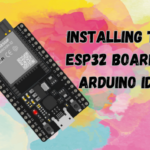
Comments (2)